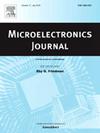Three-dimensional design of SOI LDMOS with high-k film trench and L-shaped gate
IF 1.9
3区 工程技术
Q3 ENGINEERING, ELECTRICAL & ELECTRONIC
引用次数: 0
Abstract
Based on silicon-on-insulator (SOI) technology, a lateral double-diffused metal-oxide-semiconductor (LDMOS) with high-k film trench (HKT) and L-shaped gate (LG) is proposed in this work. The HK film surrounding the oxide trench can adjust the electric flux flow and the trench/drift interface electric field distribution, which improves both of breakdown voltage (BV) and specific on-resistance (Ron,sp). Moreover, the LG can modulate the three-dimensional (3-D) surface electric field distribution in the xoz-plane, which prevents the premature breakdown at gate end for the device. In the xoz-plane, the LG dramatically enlarges the current channel width. Correspondingly, the drain needs to expand the area in top view, which can provide sufficient conductive path to match the widened current channel. In a consequence, Ron,sp significantly decreases. Therefore, BV and Ron,sp are both effectively improved for the proposed device. The 3-D simulation results show that in comparison with the conventional HKT SOI LDMOS (BV ∼ 255 V, Ron,sp ∼ 8.72 mΩ∙cm2), BV (287 V) is increased by 11.3 % while Ron,sp (5.37 mΩ∙cm2) is reduced by 38 % for the proposed structure, which results in a sufficiently high Figure-of-Merit (FOM, = BV2/Ron = 15.3 MW/cm2). In addition, the device performance characteristics (e.g. temperature and transconductance) are also discussed in this work.
求助全文
约1分钟内获得全文
求助全文
来源期刊

Microelectronics Journal
工程技术-工程:电子与电气
CiteScore
4.00
自引率
27.30%
发文量
222
审稿时长
43 days
期刊介绍:
Published since 1969, the Microelectronics Journal is an international forum for the dissemination of research and applications of microelectronic systems, circuits, and emerging technologies. Papers published in the Microelectronics Journal have undergone peer review to ensure originality, relevance, and timeliness. The journal thus provides a worldwide, regular, and comprehensive update on microelectronic circuits and systems.
The Microelectronics Journal invites papers describing significant research and applications in all of the areas listed below. Comprehensive review/survey papers covering recent developments will also be considered. The Microelectronics Journal covers circuits and systems. This topic includes but is not limited to: Analog, digital, mixed, and RF circuits and related design methodologies; Logic, architectural, and system level synthesis; Testing, design for testability, built-in self-test; Area, power, and thermal analysis and design; Mixed-domain simulation and design; Embedded systems; Non-von Neumann computing and related technologies and circuits; Design and test of high complexity systems integration; SoC, NoC, SIP, and NIP design and test; 3-D integration design and analysis; Emerging device technologies and circuits, such as FinFETs, SETs, spintronics, SFQ, MTJ, etc.
Application aspects such as signal and image processing including circuits for cryptography, sensors, and actuators including sensor networks, reliability and quality issues, and economic models are also welcome.
 求助内容:
求助内容: 应助结果提醒方式:
应助结果提醒方式:


